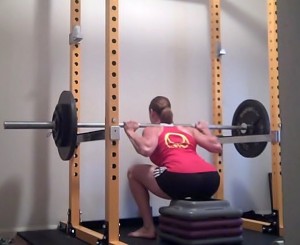 By “shake up” your workouts I’m in no way referring to the infamous “Shake Weight”, so don’t even think about it. That’s not a valid exercise or training technique, no matter how you do it.
By “shake up” your workouts I’m in no way referring to the infamous “Shake Weight”, so don’t even think about it. That’s not a valid exercise or training technique, no matter how you do it.
Anyway . . .
I love the basic barbell and bodyweight exercises and their variations.
These basic exercises have been staples of my workouts for months:
- Squats TO a box (pictured above)
- Kettlebell swings
- Push-ups
- Handstand push-ups
- Chin-ups
- Inverted rows
I primarily workout at home since I have a barbell set, power-rack, a couple kettlebells, and Jungle Gym. It’s all I need to accomplish my training and physique goals.
And because I’m limited with the exercises I perform, I have to use various training techniques to shake things up from time to time, and to keep making progress. And also to keep boredom from creeping in.
Before I share the training techniques I use in my own training, I must state that I’m not claiming to have created anything new; all of the methods I’m going to discuss are techniques I’ve learned elsewhere. I’ll do my best to credit each individual who I learned the method from with the respective training methods.
Give these techniques a shot if you’re getting bored with your current workouts or you want to bust through a plateau.
Rest/Pause
There are different variations of rest/pause training, but the method I’m referring to is that promoted by Dante Trudel of DC Training. This is a training method I experimented with for several months last year, and experienced some good results with building muscle. It’s also a great method to incorporate if you’re short on training time.
Rest/pause requires you to perform a set to failure (more on “failure” in a moment), rest about 25-30 seconds, perform another set to failure, rest about 25-30 seconds, and perform a final set to failure.
I define “failure” as stopping the set when you know you can’t complete another rep with perfect form. Banging out sloppy reps doesn’t make you any tougher — it’s just a good way to get hurt. And I don’t suggest missing a rep because it increases your chance of injury and drains recovery.
So, let’s use chin-ups as an example utilizing the rest/pause method.
- Chin-up Set #1 – 10 reps
- Rest about 25 seconds
- Chin-up Set #2 – 5 reps
- Rest about 25 seconds
- Chin-up Set #3 – 4 reps
So your rest/pause set would be 10 + 5 + 4 for a total rest/pause set of 19 reps.
How to Progress with Rest/Pause
I generally set a total rep target, such as 25-30 reps. Once you can perform a total of 25 reps (or whatever number you choose), increase the weight and start over. For dumbbell exercises I prefer to keep the reps in the 25-30 range. However, for exercises such as chin-ups you can go lower (15-20 total reps) while still being able to train safely.
Appropriate Exercises for Rest/Pause
There are certain exercises you should never (at least in my opinion) apply the rest/pause method such as squats and deadlifts. It’s just too risky. I would also stay away from using rest/pause with bent over barbell rows because it’s too taxing on the lower back.
You can perform exercises like barbell and dumbbell bench presses, but I highly recommend using a power rack and spotter. Rest/pause training is tough, and you don’t want to risk a barbell or dumbbell crushing your wind pipe or giving your face a painful make-over.
Some of my favorite exercises to incorporate rest/pause are bodyweight exercises such as push-ups, inverted rows, chin-ups, and parallel bar dips. Other great exercises are cable rows, pull-downs, calf raises (prepare to experience some crazy, painful cramps with these), triceps extensions, biceps curls, and even leg curls.
Ladders
This is a technique I first read about from Dan John. Ladders can be used for building strength, muscle, and for conditioning work.
Personally, I use ladders primarily for conditioning work. For example, last weekend I needed a quick training session before heading out to a local Oktoberfest. I asked myself, “What would I be able to do quickly that’s very challenging?”
Stupid question. But the answer was even more stupid.
I decided to do burpee + push-up ladders superset with kettlebell swing ladders.
All I did was perform 10 reps of each, rest a few seconds, 9 reps of each, rest a few seconds, 8 reps of each, all the way down to a single for each.
Here’s a visual:
- 10 burpee/push-ups
- 10 kettlebell swings
- 9 burpee/push-ups
- 9 kettlebell swings
- Repeat all the way down to 1 rep each
When you’re finished, you’ll have completed a total of 55 reps for each exercise.
Or, if you’re feeling like a total lunatic, you can go back up the ladder. Perform a single for each, rest, perform 2 reps, rest, perform 3 reps, all the way up to 10 reps.
If you want to give the ladder technique a try, test it out with “advanced” burpees.
Try to complete a ladder — from 10 reps down to one — as quickly as possible for a crazy conditioning workout.
**You’re welcome.
Those two training techniques should keep you busy until Part 2 of the 5 Training Techniques to Shake Up Your Workouts is posted where you’ll get three additional methods to change things up a bit and possibly but through a training plateau.
**Cue evil laugh. Bwa-ha-ha-ha!